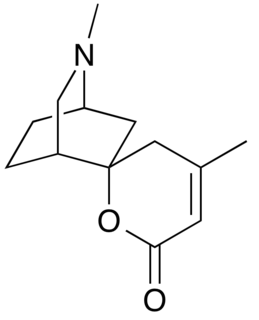{{Chembox | Reference = [1] | Name = Holothurin | ImageFile = Holothurin 2D structure (PubChem).png | ImageSize = 250px | ImageAlt = | IUPACName = {{hidden||Sodium;[(3R,4R,5R,6S)-5-[(2S,3R,4R,5S,6R)-5-[(2S,3R,4S,5R,6R)-4-[(2S,3R,4S,5R,6R)-3,5-dihydroxy-4-methoxy-6-methyloxan-2-yl]oxy-3,5-dihydroxy-6-methyloxan-2-yl]oxy-3,4-dihydroxy-6-methyloxan-2-yl]oxy-6-[[(1S,2S,5R,6S,9S,10S,13S,16S,18R)-6-[(2S)-5,5-dimethyloxolan-2-yl]-5,10-dihydroxy-2,6,13,17,17-pentamethyl-8-oxo-7-oxapentacyclo[10.8.0.02,9.05,9.013,18]icos-11-en-16-yl]oxy]-4-hydroxyoxan-3-yl]] sulfate }} | Section1 = !Identifiers |-
Contents
|
|
|-
|
|
|- | ChemSpider
|
|-
|
|
|-
|
- InChI=1S/C54H86O25S.Na/c1-22-32(56)40(68-11)37(61)44(70-22)75-41-33(57)23(2)71-45(38(41)62)74-39-24(3)72-43(36(60)35(39)59)76-42-34(58)27(79-80(65,66)67)21-69-46(42)73-30-15-17-50(8)26-20-29(55)54-47(63)78-52(10,31-14-16-48(4,5)77-31)53(54,64)19-18-51(54,9)25(26)12-13-28(50)49(30,6)7;/h20,22-25,27-46,55-62,64H,12-19,21H2,1-11H3,(H,65,66,67);/q;+1/p-1/t22-,23-,24-,25-,27-,28+,29+,30+,31+,32-,33-,34+,35-,36-,37-,38-,39-,40+,41+,42-,43+,44+,45+,46+,50-,51+,52+,53+,54-;/m1./s1Key: MAWWITJOQDJRJF-ADBICINLSA-M
|-
|
- C[C@@H]1[C@H]([C@@H]([C@H]([C@@H](O1)O[C@H]2[C@@H]([C@H](O[C@H]([C@@H]2O)O[C@@H]3[C@H](O[C@H]([C@@H]([C@H]3O)O)O[C@@H]4[C@H]([C@@H](CO[C@H]4O[C@H]5CC[C@]6([C@H](C5(C)C)CC[C@@H]7C6=C[C@@H]([C@@]89[C@]7(CC[C@@]8([C@](OC9=O)(C)[C@@H]1CCC(O1)(C)C)O)C)O)C)OS(=O)(=O)[O-])O)C)C)O)O)OC)O.[Na+]
|- | Section2 = !Properties |-
|
| C54H85NaO25S |- | Molar mass | 1189.3 g/mol |- | Section3 = }}
{{Chembox | Reference = [2] | Name = Holothurin A | ImageFile = Holothurin A.svg | ImageSize = 250px | ImageAlt = | IUPACName = {{hidden||Sodium;[(3R,4R,5R,6S)-5-[(2S,3R,4R,5S,6R)-5-[(2S,3R,4S,5R,6R)-4-[(2S,3R,4S,5R,6R)-3,5-dihydroxy-6-(hydroxymethyl)-4-methoxyoxan-2-yl]oxy-3,5-dihydroxy-6-(hydroxymethyl)oxan-2-yl]oxy-3,4-dihydroxy-6-methyloxan-2-yl]oxy-6-[[(1S,2S,5R,6S,9R,10S,13S,16S,18R)-6-(5,5-dimethyloxolan-2-yl)-5,10-dihydroxy-2,6,13,17,17-pentamethyl-8-oxo-7-oxapentacyclo[10.8.0.02,9.05,9.013,18]icos-11-en-16-yl]oxy]-4-hydroxyoxan-3-yl]] sulfate }} | Section1 = !Identifiers |-
|
|
|-
|
|
|- | ChemSpider
|
|-
|
|
|-
|
- InChI=1S/C54H86O27S.Na/c1-22-39(76-45-38(64)41(33(59)26(20-56)74-45)77-44-37(63)40(70-9)32(58)25(19-55)73-44)35(61)36(62)43(72-22)78-42-34(60)27(81-82(67,68)69)21-71-46(42)75-30-13-15-50(6)24-18-29(57)54-47(65)80-52(8,31-12-14-48(2,3)79-31)53(54,66)17-16-51(54,7)23(24)10-11-28(50)49(30,4)5;/h18,22-23,25-46,55-64,66H,10-17,19-21H2,1-9H3,(H,67,68,69);/q;+1/p-1/t22-,23-,25-,26-,27-,28+,29+,30+,31?,32-,33-,34+,35-,36-,37-,38-,39-,40+,41+,42-,43+,44+,45+,46+,50-,51+,52+,53+,54+;/m1./s1Key: KXDQPKMJSMCBEY-AEATXNOCSA-M
|-
|
- C[C@@H]1[C@H]([C@@H]([C@H]([C@@H](O1)O[C@@H]2[C@H]([C@@H](CO[C@H]2O[C@H]3CC[C@]4([C@H](C3(C)C)CC[C@@H]5C4=C[C@@H]([C@]67[C@]5(CC[C@@]6([C@](OC7=O)(C)C8CCC(O8)(C)C)O)C)O)C)OS(=O)(=O)[O-])O)O)O)O[C@H]9[C@@H]([C@H]([C@@H]([C@H](O9)CO)O)O[C@H]1[C@@H]([C@H]([C@@H]([C@H](O1)CO)O)OC)O)O.[Na+]
|- | Section2 = !Properties |-
|
| C54H85NaO27S |- | Molar mass | 1221.3 g/mol |- | Section3 = }}
{{Chembox | Reference = [3] | Name = Holothurin B | ImageFile = Holothurin B.svg | ImageSize = 250px | ImageAlt = | IUPACName = {{hidden||Sodium;[(3R,4R,5R,6S)-6-[[(5R,6R,10S,13S,16S)-6-[(2S)-5,5-dimethyloxolan-2-yl]-5,10-dihydroxy-2,6,13,17,17-pentamethyl-8-oxo-7-oxapentacyclo[10.8.0.02,9.05,9.013,18]icos-11-en-16-yl]oxy]-4-hydroxy-5-[(2S,3R,4S,5S,6R)-3,4,5-trihydroxy-6-methyloxan-2-yl]oxyoxan-3-yl]] sulfate }} | OtherNames = | Section1 = !Identifiers |-
|
|
|-
|
|
|- | ChemSpider
|
|-
|
|
|-
|
- InChI=1S/C41H64O17S.Na/c1-19-27(43)29(45)30(46)32(53-19)55-31-28(44)22(58-59(49,50)51)18-52-33(31)54-25-12-14-37(6)21-17-24(42)41-34(47)57-39(8,26-11-13-35(2,3)56-26)40(41,48)16-15-38(41,7)20(21)9-10-23(37)36(25,4)5;/h17,19-20,22-33,42-46,48H,9-16,18H2,1-8H3,(H,49,50,51);/q;+1/p-1/t19-,20?,22-,23?,24+,25+,26+,27-,28+,29+,30-,31-,32+,33+,37-,38?,39-,40+,41?;/m1./s1Key: XPKZSKANINADOD-ZSNWYRGCSA-M
|-
|
- C[C@@H]1[C@H]([C@@H]([C@H]([C@@H](O1)O[C@@H]2[C@H]([C@@H](CO[C@H]2O[C@H]3CC[C@]4(C(C3(C)C)CCC5C4=C[C@@H](C67C5(CC[C@@]6([C@@](OC7=O)(C)[C@@H]8CCC(O8)(C)C)O)C)O)C)OS(=O)(=O)[O-])O)O)O)O.[Na+]
|- | Section2 = !Properties |-
|
| C41H63NaO17S |- | Molar mass | 883 g/mol |- | Section3 = }}
The holothurins are a group of toxins originally isolated from the sea cucumber Actinopyga agassizii . [4] They are contained within clusters of sticky threads called Cuvierian tubules which are expelled from the sea cucumber as a mode of self-defence. [5] The holothurins belong to the class of compounds known as saponins and are anionic surfactants which can cause red blood cells to rupture. [6] [7] The holothurins can be toxic to humans if ingested in high amounts.
















